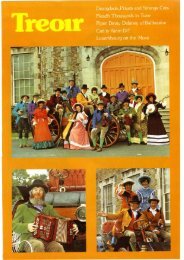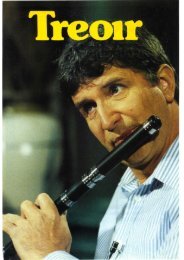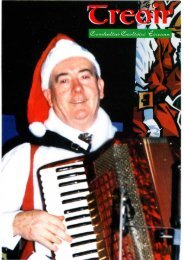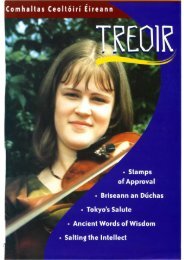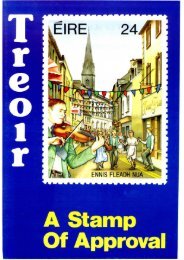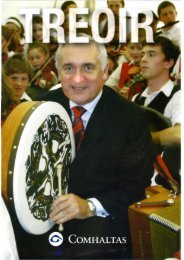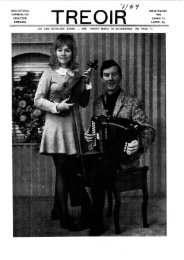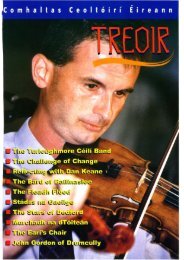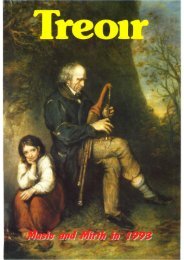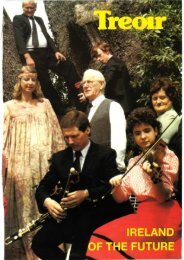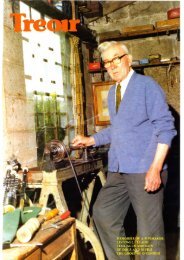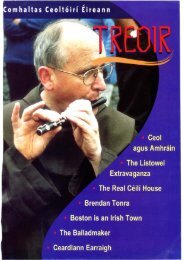You also want an ePaper? Increase the reach of your titles
YUMPU automatically turns print PDFs into web optimized ePapers that Google loves.
S COMHALTASForgottenPipers ofTipperaryFintan DeereNo Class of Irish worthies has beentreated with less consideration thanminstrels and musicians in biographicalliterature. So wrote Captain FrancisO'Neill in 1913, when he sought to putmatters right and give Irish musicianstheir recognition in a book entitled'Irish Minstrels and Musicians'. Despitehis efforts, most of those listed in hisbook have since disappeared again intooblivion and Mercier Press revivedtheir memory through the republicationof O'Neill's book.O'Neill recounts the stories ofharpers, pipers, fiddlers, flautists, folkmusicians and dancing masters whohave combined to ensure thattraditional Irish music survived throughto this century. Not alone those whoenjoy this type of entertainment butindeed all who approve of thepreservation of unique elements ofIrish culture owe them a debt.Tipperary is well endowed with suchpeople but for the most part they gounrecognised for their contribution.One such was William Talbot, born inRoscrea in 1780 and blinded by anattack of smallpox at the age of 15.He devoted himself to music andtravelled the country in great demand.He moved to Dublin, opening a tavernin Little Mary Street and played eachevening in another hostelry in CapelStreet. His leisure hours were spenttuning and stringing pianos andorgans, quite a feat given his loss ofeyesight. His reputation spread sowidely that he ended up playingbefore King George IV andentertained the audiences at severalLondon theatres. He was once quotedas saying: 'If we forget our own oldmusic, what is there to remember inits place? - words, alas!' This commentprobably summed up the purpose towhich he dedicated his life.Native of CahirEdmund Keating Hyland was born inthe same year as Talbot and alsobecame blind. Hyland, a native ofCahir, is credited with havingcomposed The Fox Chase' with itsdescription of the horns, the tallyho,the hounds in full chase and the deathof the fox, when he was a youthful 19.This, if correct, would suggestextraordinary precocity, because hehad not even studied musical theoryat the time. Like Talbot he 'wascommanded' to play for King GeorgeIV in 1821 and His Majesty is reputedto having ordered the piper a new setof pipes costing fifty guineas. Hylanddied in Dublin in 1845.Also from Cahir was ThomasO 'Hannigan, born in 1806, who yetagain went blind in his teens.O'Hannigan served an apprenticeshipof four years to various Munsterpipers and following the example ofothers of his profession who reachedcelebrity status, went to Dublin toearn a living. He performed to muchdelight at the Adelphi and AbbeyStreet theatres and later earned thecoveted distinction of playing beforeQueen Victoria and at an OxfordUniversity commemoration. He died'from a stroke of apoplexy' in Bray.In the early nineteenth century, apiper named Jack Rotchford achievedsome renown in his nativeSlieveardagh. In the absence of hardfacts, it is not surprising that legendsabout his life survive. One storyconcerns a neighbour of Rotchford'scalled 'Old Butler' ofWilliamstown.Butler was visited one day by a friendand the two of them had a bet as towhether Rotchford or a musicianacquaintance of the visitor was thebetter performer. To decide the issue,both pipers were summoned toperform right through the night.The judge could not decide betweenthem but the bet was settled when askylark landed on the windowsill andtapped and sang approvingly whenRotchford played, but remained silentwhile the other contestant performed.Drunk or SoberAnother piper from the same areawas James Coady, who travelled thecountry, much to the annoyance of hiswife, according to stories related byO'Neill. The wife said that he gave herno money during his periodic visits40



